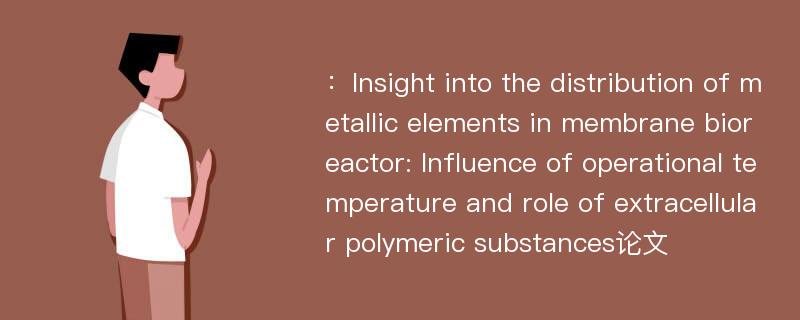
本文主要研究内容
作者(2019)在《Insight into the distribution of metallic elements in membrane bioreactor: Influence of operational temperature and role of extracellular polymeric substances》一文中研究指出:The distribution of metallic elements in a submerged membrane bioreactor(MBR) was revealed at different temperatures using inductively coupled plasma-optical emission spectrometry(ICP-OES), and the role of extracellular polymeric substances(EPS) was probed by integrating scanning electron microscopy(SEM) with confocal laser scanning microscopy(CLSM) over long-term operation. More metallic elements in the influent were captured by suspended sludge and built up in the fouling layer at lower temperature. The concentration of metallic elements in the effluent was 5.60 mg/L at 10°C operational temperature, far lower than that in the influent(51.35 mg/L). The total contents of metallic elements in suspended sludge and the membrane fouling layer increased to 40.20 and 52.19 mg/g at 10°C compared to 35.14 and 32.45 mg/g at 30°C, and were dominated by the organically bound fraction. The EPS contents in suspended sludge and membrane fouling layer sharply increased to 37.88 and 101.51 mg/g at 10°C, compared to 16.87 and 30.03 mg/g at 30°C. The increase in EPS content at lower temperature was responsible for the deposition of more metallic ions. The strong bridging between EPS and metallic elements at lower temperature enhanced the compactness of the fouling layer and further decreased membrane flux. This was helpful for understanding the mechanism of membrane fouling at different operational temperatures and the role of EPS, and also of significance for the design of cleaning strategies for fouled membranes after long-term operation.
Abstract
The distribution of metallic elements in a submerged membrane bioreactor(MBR) was revealed at different temperatures using inductively coupled plasma-optical emission spectrometry(ICP-OES), and the role of extracellular polymeric substances(EPS) was probed by integrating scanning electron microscopy(SEM) with confocal laser scanning microscopy(CLSM) over long-term operation. More metallic elements in the influent were captured by suspended sludge and built up in the fouling layer at lower temperature. The concentration of metallic elements in the effluent was 5.60 mg/L at 10°C operational temperature, far lower than that in the influent(51.35 mg/L). The total contents of metallic elements in suspended sludge and the membrane fouling layer increased to 40.20 and 52.19 mg/g at 10°C compared to 35.14 and 32.45 mg/g at 30°C, and were dominated by the organically bound fraction. The EPS contents in suspended sludge and membrane fouling layer sharply increased to 37.88 and 101.51 mg/g at 10°C, compared to 16.87 and 30.03 mg/g at 30°C. The increase in EPS content at lower temperature was responsible for the deposition of more metallic ions. The strong bridging between EPS and metallic elements at lower temperature enhanced the compactness of the fouling layer and further decreased membrane flux. This was helpful for understanding the mechanism of membrane fouling at different operational temperatures and the role of EPS, and also of significance for the design of cleaning strategies for fouled membranes after long-term operation.
论文参考文献
论文详细介绍
论文作者分别是来自Journal of Environmental Sciences的,发表于刊物Journal of Environmental Sciences2019年02期论文,是一篇关于,Journal of Environmental Sciences2019年02期论文的文章。本文可供学术参考使用,各位学者可以免费参考阅读下载,文章观点不代表本站观点,资料来自Journal of Environmental Sciences2019年02期论文网站,若本站收录的文献无意侵犯了您的著作版权,请联系我们删除。
